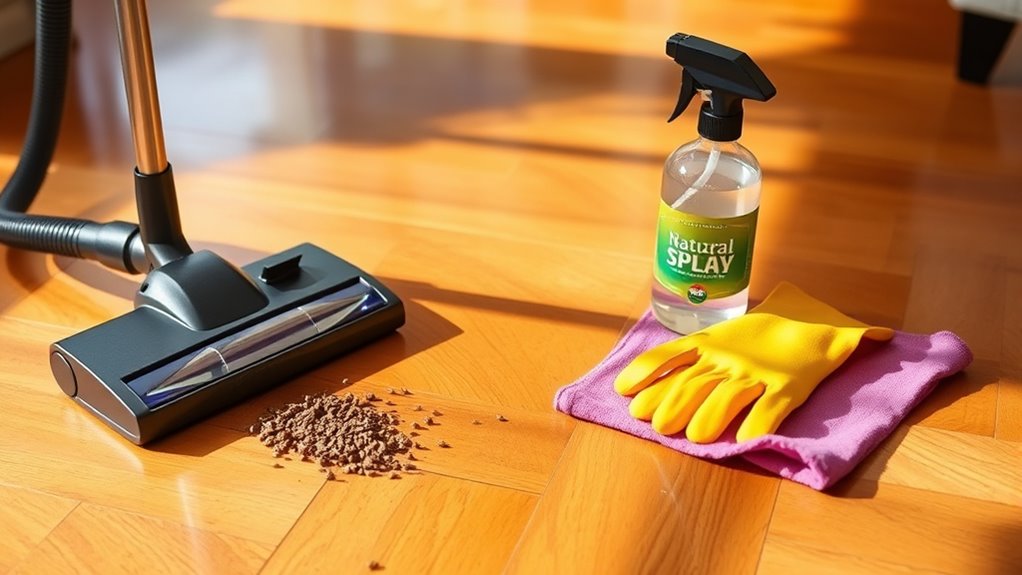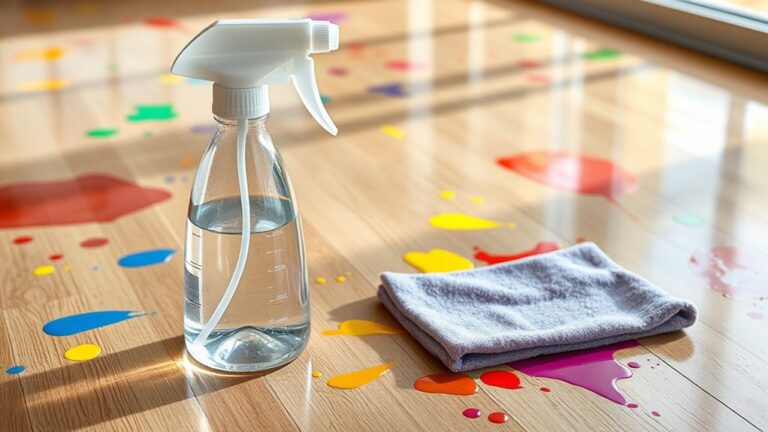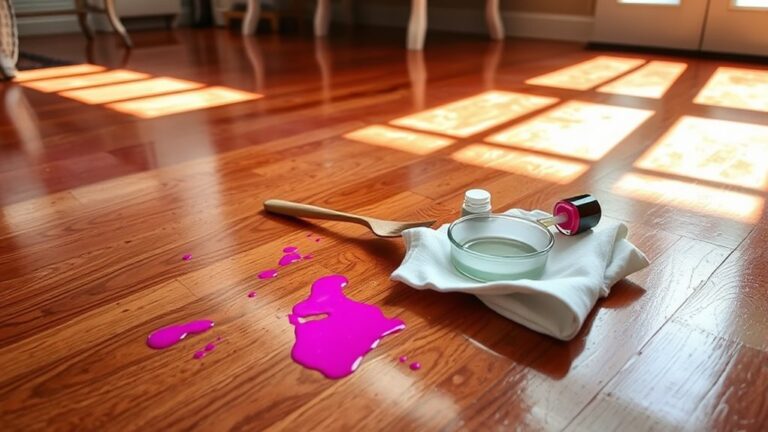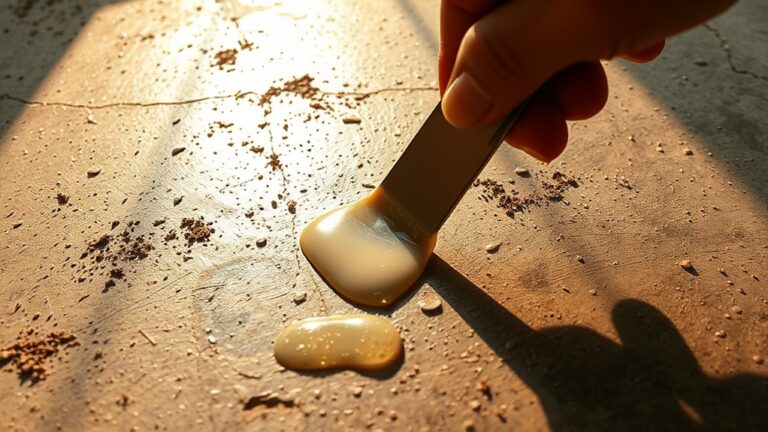To get rid of fleas on hardwood floors, start by inspecting for flea dirt and insects near pet areas. Remove all movable items to expose the floor, then vacuum thoroughly using crevice tools, focusing on cracks. Dispose of vacuum contents immediately outdoors. Choose flea control products suited for hardwood, apply with protection, and guarantee ventilation. You can also use natural remedies like food-grade diatomaceous earth. Consistency is key to breaking the flea life cycle. Explore the next steps to fully tackle infestations safely and effectively.
Identifying Flea Infestations on Hardwood Floors
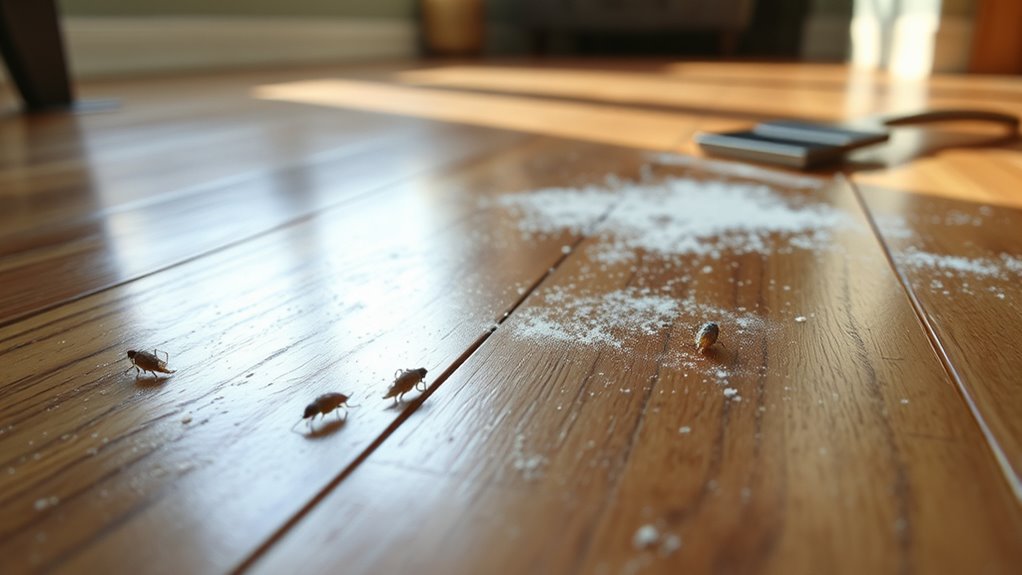
Although fleas are small and quick, you can identify their presence on hardwood floors by closely inspecting for subtle signs such as tiny dark specks (flea dirt), small reddish-brown insects, or unusual pet scratching behavior. Flea behavior includes jumping and moving quickly across surfaces, making visual detection challenging. Infestation signs often manifest through pet discomfort, increased scratching, or visible flea dirt embedded in floor crevices. You should examine areas where pets rest or frequent, as fleas tend to congregate there due to proximity to hosts. Additionally, flea dirt will appear as tiny black specks that, when moistened on a white cloth, turn reddish-brown—proof of digested blood. Recognizing these infestation signs promptly allows you to act decisively, maintaining your freedom from persistent flea problems on hardwood floors.
Preparing the Area for Flea Treatment
Before applying any flea treatment, you’ll need to thoroughly prepare the hardwood floor area to maximize effectiveness and safety. Start by removing all movable items such as rugs, furniture, and pet bedding. This exposes the floor surface, allowing treatments to penetrate flea habitats hidden in cracks and crevices. Understanding the flea lifecycle is essential; treatments must target different stages—eggs, larvae, and adults—to prevent reinfestation. Timing your treatment is key: apply it when flea activity peaks, often after vacuuming to eliminate debris and disrupt eggs. Make sure pets and people are out of the area during application to avoid exposure. Finally, seal off the treated zone to maintain ideal contact time, enhancing treatment efficacy and securing your freedom from persistent flea problems.
Vacuuming Techniques to Remove Fleas and Eggs
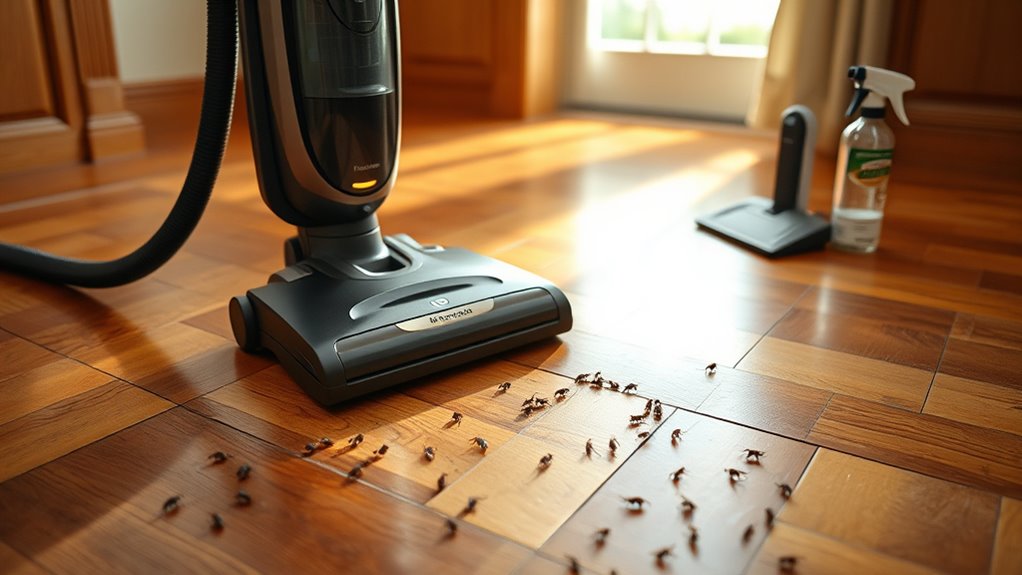
When you vacuum hardwood floors to remove fleas and their eggs, it’s crucial to use a vacuum with strong suction and a rotating brush to dislodge pests from cracks and crevices. Opt for vacuuming attachments like crevice tools and upholstery brushes to reach baseboards, corners, and under furniture where fleas hide. Maintain a consistent vacuuming frequency—daily or every other day during infestation—to interrupt the flea life cycle effectively. After vacuuming, immediately dispose of the vacuum bag or empty the canister outside to prevent re-infestation. Pay careful attention to areas frequented by pets, as eggs and larvae tend to accumulate there. By combining powerful suction, targeted attachments, and disciplined vacuuming frequency, you’ll greatly reduce flea populations and move closer to reclaiming your hardwood floors.
Choosing and Applying Flea Control Products Safely
Since choosing the right flea control products is critical for both effectiveness and safety, you should carefully evaluate formulations based on your household environment and the presence of pets or children. Prioritize product selection that explicitly states suitability for hardwood floors to prevent surface damage. Consider chemical safety by reviewing active ingredients and toxicity levels; opt for products with lower environmental impact when possible. Always follow manufacturer instructions for dilution and application rates to minimize risks. Use protective gear, such as gloves and masks, to reduce exposure during treatment. Ascertain treated areas are well-ventilated and restrict access for vulnerable individuals until residues dry completely. By adhering to these guidelines, you maintain control over both flea eradication and the safety of your living space, preserving your freedom to enjoy a clean, healthy home.
Natural Remedies to Eliminate Fleas From Hardwood Floors
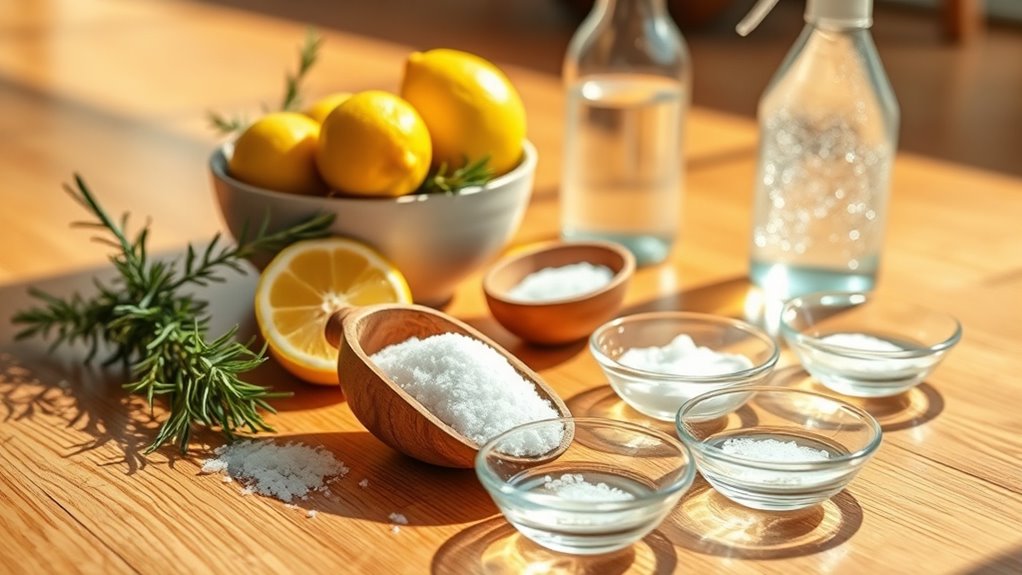
While chemical flea control products offer targeted solutions, you might prefer natural alternatives that minimize exposure to synthetic substances on your hardwood floors. Herbal solutions like diatomaceous earth provide a mechanical means to dehydrate fleas without chemicals. Apply food-grade diatomaceous earth lightly across the floor, allowing it to settle into crevices. Essential oils, such as lavender, eucalyptus, and peppermint, have documented insect-repellent properties; dilute them properly in water and use a spray bottle to mist the floor. Avoid oversaturation to protect the wood finish. These natural remedies work synergistically by disrupting flea respiration and deterring their presence. Remember, consistent application is key to breaking the flea life cycle. By integrating herbal solutions and essential oils, you maintain a safer environment while effectively reducing flea populations on hardwood surfaces.
Preventative Measures to Keep Fleas Away
To effectively prevent fleas from infesting your hardwood floors, you need to implement a combination of environmental control and routine maintenance. Flea prevention hinges on minimizing conditions that support flea life cycles while maintaining the integrity of your hardwood surfaces. Focus on consistent hardwood maintenance and hygiene to disrupt flea habitats.
- Vacuum floors and furniture regularly to remove flea eggs and larvae.
- Wash pet bedding weekly in hot water to eliminate fleas.
- Use flea repellents or treatments on pets as recommended by veterinarians.
- Seal cracks and crevices in hardwood 床材 to prevent flea hiding spots.
- Maintain low indoor humidity, as fleas thrive in moist environments.

